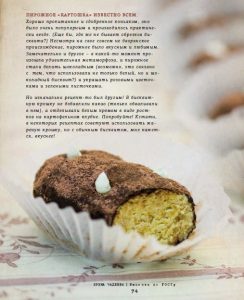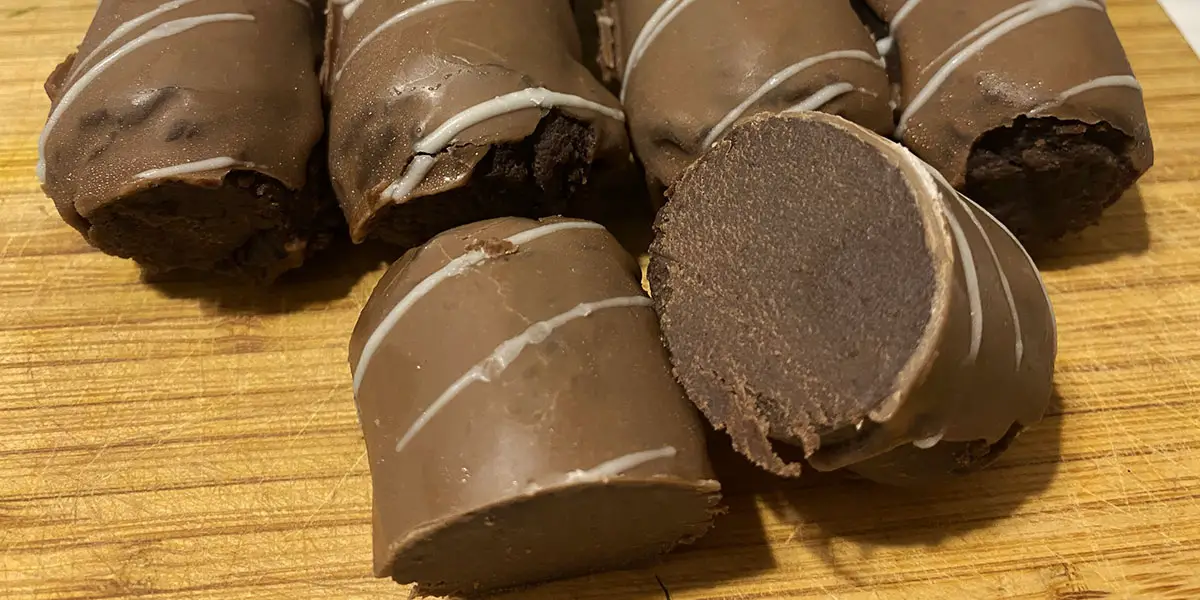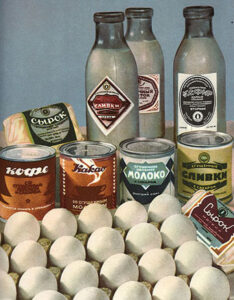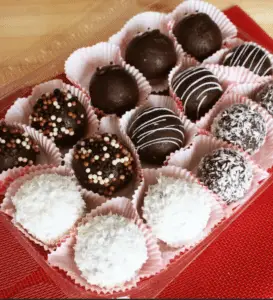Kartoshka cake, known as in Russian as “пирожное картошка” (Pirozhnoe kartoshka – literally “cake potato”), or sometimes more affectionately just картошка (kartoshka – “potato”), is a mouthwatering pastry that takes many people from the former USSR back to their childhood. Once used to prevent food loss and combat shortages, kartoshka cake spread widely in the early days of the USSR, and eventually became a Soviet staple – even in times of plenty.
Made from crumbs (cake, cookie, or bread), this otherwise no-bake dessert can be made in just 20 minutes with the addition of dairy fat and a dusting of cocoa powder, meaning that it can save on time as well as other resources while providing a delectable, simple treat.
Why Is It Called “Potato Cake?”
Почему носит такое название?
Most histories of kartoshka cake start with a mention of Runeberg cake. The story is popular in Russia: The Finnish poet Johan Runeberg was one day, sometime in the mid 1800’s, unexpectedly visited by a group of dignitaries at his home in Finland, then a part of the Russian Empire. His wife, finding only half-eaten bags of cookies in their pantry, quickly crushed them and used them in place of flour to bake a cake involving nuts, spices, jam, and fruit juice. The result was hailed by the dignitaries as an ingenious masterpiece of an invention and was soon offered in many Finnish bakeries.
Although popular, the story likely only tells one step in the eventual invention of kartoshka cake. Similar recipes for things such as bread cake appeared in the Cook’s Calendar (Календарь поваренный), published in 1808, and wheat crouton cake can be found in the Dictionary of Cookery, Service, Confectionery, and Distillery (Словаря поваренного, приспешничьего, кандиторского и дистиллаторского), published in 1796.
Many bakeries, in fact, in both tsarist and communist times, seem to have used similar recipes to rework soon-to-expire, unsold, or even slightly spoiled goods into sellable items.
Most histories will also mention that in nearly all cases, the above confections were baked, while the modern kartoshka cake is not. The modern cake additionally has a classic oblong shape and is traditionally white inside with cocoa-powder dusting outside, which makes it look suspiciously like a potato. The word “kartoshka” (картошка), in fact, directly translates as “potato.” In the full name, “pirozhnoe kartoshka,” the “пирожное” part translates to “cake.” Therefore, “potato cake” is a literal full translation of the pastry’s name.
This version became common as the USSR was industrializing its food production, which led to many innovations in local diets. Factory-producing breads and cakes meant a large amount of crumbs and waste ends. Dairy production was also being industrialized at the time, so combining these products into a useable product was a simple and sensible economic choice.
During the shortages that plagued the USSR through the end of WWII, kartoshka cake became a dessert popular in homes as well, helping people utilize every bit of food they had. Although its prevalence had an obvious connection with shortages, it became a beloved food.
How to Bake Kartoshka Cake
Как правильно готовить пирожное картошка?
Although kartoshka cake was growing in popularity, it was never featured in the Book of Healthy and Tasty Food (Книга о вкусной и здоровой пище), the iconic cookbook first produced by the Soviets in 1939 and revised in 1952 to encourage citizens to use the foods available from industrial enterprises. However, such were being made, often with wide variety in their ingredients. For instance, in the memoirs of Zinaida Pasternak (Boris Pasternak’s wife), she recalls that, in the fall of 1941, she was expecting guests the next day and was low on ingredients. She had “only rye flour in stock” and so, experimenting with the “potato” technique, she made the four into crackers with a frying pan, “crushed them, added eggs, honey, and white wine, and it turned out as delicious ‘potato’ cakes.”

The first cookbook recipe for kartoshka cake appeared in 1955, in a different cookbook called simply Cooking (Кулинария), which gave the recipe with the name “dusted potato cake” (пирожное “картошка обсыпная”). Today, you can see that recipe – and the full Cooking book now online (in Russian).
By this time, shortages were easing and kartoshka cake was increasingly eaten not necessarily because it helped use resources efficiently, but because it was a beloved and decadent treat. The recipe in Cooking, likewise, showed that the recipe could be raised to culinary art. It started not with scraps, crumbs, or whatever might be in the pantry, but with a full fresh yellow cake, baked specifically to be turned into crumbs and finished into kartoshka cake (although it also mentions that using crumbs and waste ends is also possible). Its cream was flavored with vanilla, cognac, and distilled flavors. Most other printed recipes that soon followed also called for the same – implying that starting with a whole, fresh cake and following through with culinary flair was the standard.
Thus, there are two broad variations as to how to prepare kartoshka in modern kitchens. The first starts with crumbling a whole prepared yellow or white cake into crumbs. The second usually uses store-bought cookies or crackers – but make sure that they are not too sweet or salty. Generally, something similar to the English digestive biscuit, a light shortbread, or even an animal cracker will work. You can also find recipes that use gingerbread – which will give it an additional spice kick – but again, the cookie should not be too sweet. You can also use dried bread. Note that purists will generally argue for the whole, fresh cake as the route to a “true” kartoshka cake, however.
Other, less controversial, variations sometimes change the chocolate coating. Some use a chocolate glaze, although the majority use cocoa powder and powdered sugar, which seems to also be the older variant. Some people choose to add pure vanilla or other extracts and a little salt into the dough as they prepare it, but it is not required. The health conscious might replace some or all of the sweetened condensed milk with sour cream for less sugar or with soft farmer’s cheese, which will lower the calories and boost the protein. You may also choose to add walnuts or pecans to taste. A last, more adult version will use cognac, brandy, or liqueur as an additional flavor –which has long been part of these types of cake recipes.
In short, variations still abound in the world of kartoshka cakes. Make it to your own taste. The most important thing to ensure is that the mixture you create is moist and able to be formed into potato-like balls that keep their shape and texture. You can use an ice cream scooper to keep them all the same size. Chill before serving to ensure that they are solid. All this will help in your final presentation of these delicious little bites.
How to Enjoy Your Kartoshka Cake
Как правильно есть пирожное картошка?
Kartoshka cake in Russia is most often served with tea or coffee. This may be after dinner with the family, as a snack with guests who have arrived, or as a way to celebrate Mother’s Day, Easter, New Year, or other holidays.
You can also buy kartoshka cake in several brands from nearly any grocery store across much of the former USSR. You’ll find packs of them stocked with the rest of the cakes. If you are adverse to liqueur flavorings, you might want to check the labels carefully as some will use these for both flavor and as a preservative.
The best kartoshka cake is likely to be fresh, enjoyed in a kitchen or a café while chatting.
Kartoshka cake should be chilled for at least an hour after they are made. The chilling will ensure that the pastry is solid and will not fall apart very easily. Chilling will also grant it a texture that will make the pastry feel more solid in chewing and less squishy. You can put the finished kartoshka cake in cupcake liners to be served, garnish with butter cream, nuts, or mint leaves, or simply arrange them on a plate to be eaten by hand as a finger pastry.
Let’s Cook!
Давай приготовим!
See below for a free recipe for kartoshka using cookies.
| Kartoshka | Картошка |
Ingredients
Instructions 1. Melt butter in a sauce pan. 2. Place cookies and half the nuts into blender and pulse until they turn into fine crumbs. 3. Chop the rest of the nuts with a knife. 4. Mix the crumbs with cocoa powder and chopped nuts. 5. Add melted butter and condensed milk into cookie mixture. Mix well until you get dough-like consistency. You can add cognac for added flavor. 6. Take a scoop of dough (I use an ice cream scoop) and roll it into a ball or oval shaped “potato” to make it look more like a classic version. 7. When all the balls are done, place them in refrigerator and let them cool for 15 minutes. 8. Sieve cocoa powder over the balls turning them several times to make sure they are covered on all sides. |
Ингредиенты
Инструкции 1. В кастрюле растопить сливочное масло. 2. Поместите печенье и половину орехов в блендер и взбивайте, пока они не превратятся в мелкую крошку. 3. Остальные орехи измельчить ножом. 4. Смешайте бисквитную крошку с какао-порошком и измельченными орехами. 5. Добавить в бисквитную смесь топленое масло и сгущенку. Хорошо перемешайте, пока не получите тестообразную консистенцию. Вы можете добавить коньяк для придания аромата. 6. Возьмите лопатку теста (я использую лопатку для мороженого) и скатайте ее в шар или овальную «картошку», чтобы она выглядела более похожей на классический вариант. 7. Когда все шарики будут готовы, поместите их в холодильник и дайте остыть в течение 15 минут. 8. Просейте какао-порошок через шарики, несколько раз перевернув их, чтобы убедиться, что они покрыты со всех сторон. |
See below for a second kartoshka recipe that utilizes sponge cake instead.
| Kartoshka | Картошка |
Ingredients
Instructions Tear the sponge cake into pieces and put in to preheated to 100C (210 F) oven for 20 min to dry the cake a bit. In a bowl beat up the butter and condensed milk using a wooden spoon. Blitz the prepared sponge cake in a blender until you have coarse crumbs, add cognac. Mix in butter and condensed milk. Form small potato-like cakes and powder them in cocoa. Put in a fridge for at least one hour. |
Ингредиенты
Инструкции Разорвите бисквит на кусочки и поставьте в разогретую до 100C (210 F) духовку на 20 минут, чтобы пирог немного просох. В миске взбить с маслом и сгущенным молоком , используя деревянную ложку. Приготовленный бисквит взбить в блендере в панировочные сухари, всыпать коньяк. Вмешать масло и сгущенное молоко. Сформируйте небольшие лепешки, похожие на картофель, и присыпьте их какао. Поставить в холодильник минимум на час. |
Our Favorite Kartoshka Cake Videos
Below is a YouTube video in which the speaker prepares what she says is a family favorite, an easy kartoshka recipe that takes her just five minutes. She speaks clearly, and at a pretty slow pace for new Russian language learners.
Below is another video featuring a speaker that does talk at a little faster rate, but does a good job of displaying the quick and easy recipe. She also gives tips on how to do it in other ways, if you would like to add variation. The video also has English subtitles already attached.
By clicking through for this last video, you can find short documentary on kartoshka cake – including history, health implications, factory production, and a bit on its American cousin – the cake pop.










